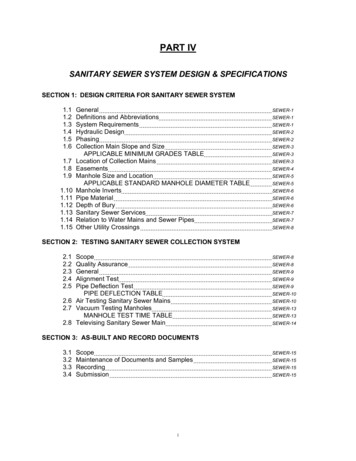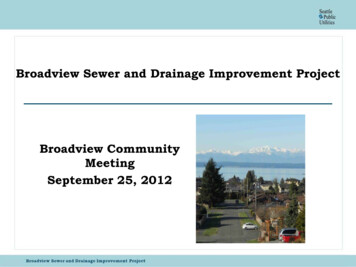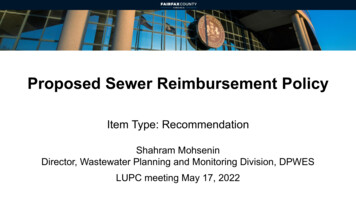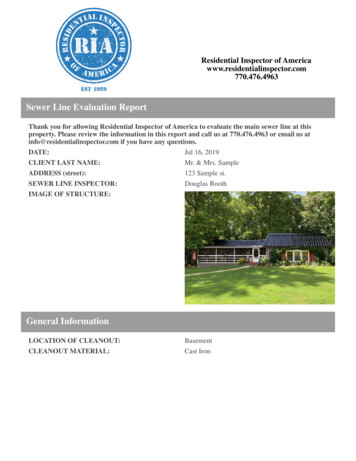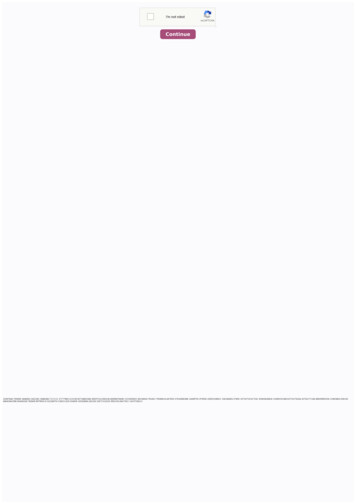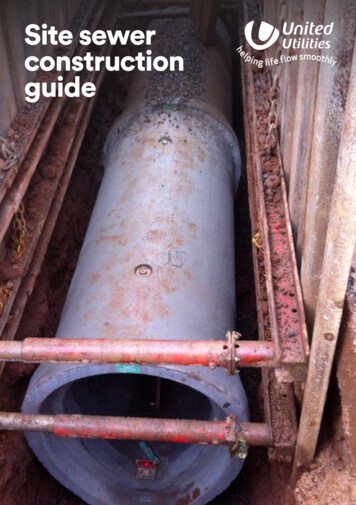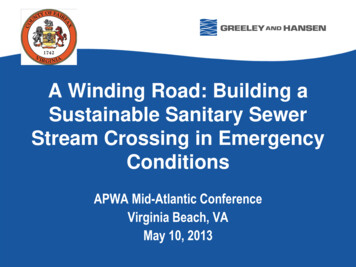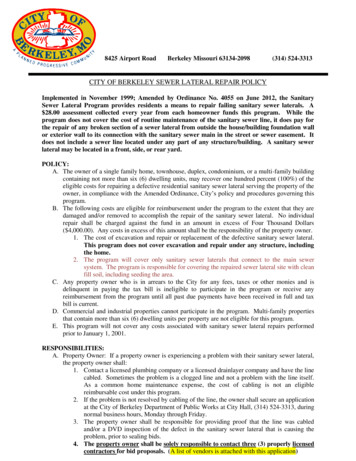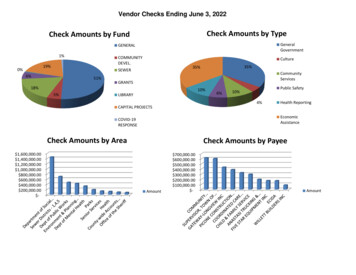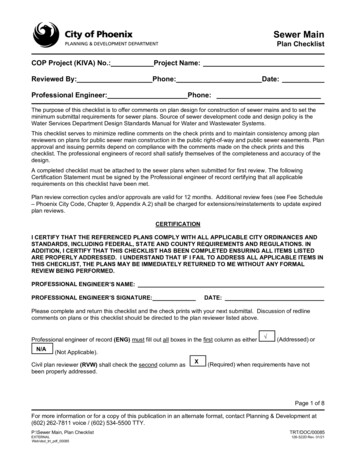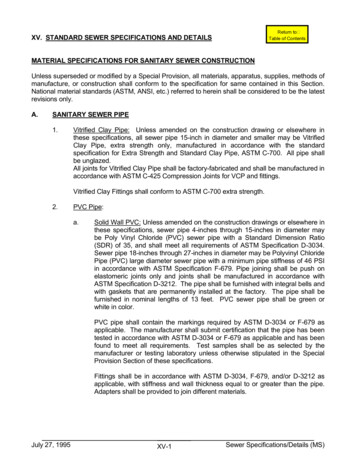
Transcription
Return toTable of ContentsXV. STANDARD SEWER SPECIFICATIONS AND DETAILSMATERIAL SPECIFICATIONS FOR SANITARY SEWER CONSTRUCTIONUnless superseded or modified by a Special Provision, all materials, apparatus, supplies, methods ofmanufacture, or construction shall conform to the specification for same contained in this Section.National material standards (ASTM, ANSI, etc.) referred to herein shall be considered to be the latestrevisions only.A.SANITARY SEWER PIPE1.Vitrified Clay Pipe: Unless amended on the construction drawing or elsewhere inthese specifications, all sewer pipe 15-inch in diameter and smaller may be VitrifiedClay Pipe, extra strength only, manufactured in accordance with the standardspecification for Extra Strength and Standard Clay Pipe, ASTM C-700. All pipe shallbe unglazed.All joints for Vitrified Clay Pipe shall be factory-fabricated and shall be manufactured inaccordance with ASTM C-425 Compression Joints for VCP and fittings.Vitrified Clay Fittings shall conform to ASTM C-700 extra strength.2.PVC Pipe:a.Solid Wall PVC: Unless amended on the construction drawings or elsewhere inthese specifications, sewer pipe 4-inches through 15-inches in diameter maybe Poly Vinyl Chloride (PVC) sewer pipe with a Standard Dimension Ratio(SDR) of 35, and shall meet all requirements of ASTM Specification D-3034.Sewer pipe 18-inches through 27-inches in diameter may be Polyvinyl ChloridePipe (PVC) large diameter sewer pipe with a minimum pipe stiffness of 46 PSIin accordance with ASTM Specification F-679. Pipe joining shall be push onelastomeric joints only and joints shall be manufactured in accordance withASTM Specification D-3212. The pipe shall be furnished with integral bells andwith gaskets that are permanently installed at the factory. The pipe shall befurnished in nominal lengths of 13 feet. PVC sewer pipe shall be green orwhite in color.PVC pipe shall contain the markings required by ASTM D-3034 or F-679 asapplicable. The manufacturer shall submit certification that the pipe has beentested in accordance with ASTM D-3034 or F-679 as applicable and has beenfound to meet all requirements. Test samples shall be as selected by themanufacturer or testing laboratory unless otherwise stipulated in the SpecialProvision Section of these specifications.Fittings shall be in accordance with ASTM D-3034, F-679, and/or D-3212 asapplicable, with stiffness and wall thickness equal to or greater than the pipe.Adapters shall be provided to join different materials.July 27, 1995XV-1Sewer Specifications/Details (MS)
b.PVC Profile Gravity Sewer Pipe: Unless amended on the constructiondrawings or elsewhere in these specifications, sewer pipe 8-inches through 48inches may be PVC profile gravity sewer pipe manufactured in accordance withthe requirements of ASTM F-794. The minimum pipe stiffness shall be 46 PSI.All seams on the completed pipe shall be thermally fused. Glued seams willnot be allowed.The pipe shall be produced with integral bell and spigot end construction withelastomeric seals and shall conform to all requirements of ASTM D-3212.Joining shall be by rubber gaskets that conform in all respects to the physicalrequirements specified by ASTM F-477 for low head applications. Thelubricant used for assembly shall be as recommended by the manufacturer andshall have no detrimental effect on either the pipe or the rubber gasket.The average nominal inside diameter and manufacturing tolerance shall be aslisted for stiffness Series 46 in Table IA for open profile pipe and Table IB forclosed profile pipe of ASTM F-794. The pipe shall be furnished in nominallengths of 13 feet and shall contain all markings required by ASTM F-794.One sample of each size pipe specified, from the production runs for thisproject, shall be tested in accordance with the requirements of ASTM F-794.The manufacturer shall furnish certification that the pipe was manufactured,sampled, tested and inspected in accordance with and has been found to meetthe requirements of ASTM F-794 in all respects.Fittings shall be in accordance with ASTM F-794, D-3212, and/or D-3034 asapplicable, with stiffness and wall thickness equal to or greater than the pipe.Adapters shall be provided to join different materials.(c)PVC Corrugated Sewer Pipe: Unless amended on the construction drawingsor elsewhere in these specifications, sewer pipe 8-inches through 18-inchesmay be Polyvinyl Chloride Corrugated Sewer Pipe with a smooth interior,manufactured in accordance with ASTM F-949. The pipe shall be producedwith integral bell and spigot construction with elastomeric seals and shallconform to all requirements to ASTM D-3212. Joining shall be by rubbergaskets that conform to the requirements of ASTM F-477. The pipe shall befurnished in nominal lengths of 12.5 feet and shall contain all markings requiredby ASTM F-949. One sample of each pipe size specified, from the productionruns of this project, shall be tested in accordance with the requirements ofASTM F-949. The manufacturer shall furnish certification that the pipe wasmanufactured, sampled, tested, and inspected in accordance with and hasbeen found to meet the requirements of ASTM F-949 in all respects.Fittings shall be in accordance with ASTM F-949, D-3034, and/or D-3212 asapplicable, with stiffness and wall thickness equal to or greater than the pipe.Adapters shall be provided to join different materials.July 27, 1995XV-2Sewer Specifications/Details (MS)
3.Reinforced Concrete Pipe:Unless amended on the construction drawings orelsewhere in these specifications, all sanitary sewer pipe 18-inch in diameter andlarger may be reinforced concrete pipe, Class IV minimum, manufactured with "C"thickness, and conforming to Standard Specification for Reinforced Concrete, StormDrain, and Sewer Pipe, ASTM C-76 and with the following modifications:Sacrificial Concrete: This specification is intended to provide sacrificial concrete onthe inside of all reinforced concrete sewer pipe. Amendments will be made, asnecessary, in the Special Provision Section of this contract to maintain this designand/or specify other acceptable measures when sacrificial concrete is not feasible forlarge diameter pipe.In lieu of sacrificial concrete, reinforced concrete pipe may be manufactured withcalcareous aggregate. If this option is chosen, all coarse aggregate used in the pipeshall be limestone or dolomite, and the alkalinity of the finished pipe shall be aminimum of 50% when expressed as calcium carbonate equivalent.Section 9 Design Tables: All Class IV RCP and 48-inch and smaller Class V RCPshall have circular reinforcement (only), equal to the requirements for Wall Breinforcement. The reinforcement shall be placed within C wall (only) the requireddistance from the outside surface of the pipe for a pipe having Wall B thickness.All Class V Reinforced Concrete Pipe 54-inch inside diameter and larger shall befurnished with Wall C thickness and Wall C circular reinforcement (only) in accordancewith ASTM C-76 Table 5. However 54-inch and larger RCP shall be manufacturedwith calcareous aggregate as specified above.Special designs may be submitted by the manufacturer in accordance with Section 7of ASTM C-76 and will be subject to the review and approval of the Engineer.Section 5 Cement: The cement shall have a maximum tricalcium aluminate (3CaOAl2O ) content not to exceed eight (8) percent. The Contractor shall submit to the3Engineer a certificate from the cement manufacturer stating the guaranteed maximumtricalcium aluminate content.Pipe Length: The minimum nominal laying length of the pipe shall be not less than 8feet for 18" and 21" pipe and not less than 12 feet for pipe 24" and larger. Shorterlengths may be provided where required to maintain manhole location and forproviding a flexible joint within two (2) feet of the exterior wall of the manhole.Tests: Acceptability of reinforced concrete pipe in all diameters and classes shall beon the basis of three edge bearing tests for the load required to produce a 0.01 inchcrack and ultimate failure of the pipe, absorption tests on selected samples of concretetaken from the pipe wall, by material tests required by Section 6 of ASTM C-76 and byvisual inspection of the pipe to determine its conformance to design and its freedomfrom defects.July 27, 1995XV-3Sewer Specifications/Details (MS)
All tests shall be performed by an independent testing laboratory and certified testreports submitted to the Engineer. If calcareous aggregate is used, certified testreports shall be submitted stating that the aggregate used is limestone or dolomite andthat the alkalinity of the finished pipe is at least 50% when expressed as calciumcarbonate equivalent. Test samples shall be selected at random by the testinglaboratory except that at least one sample shall be chosen from the production runfrom which each shipment is made.Joints for sanitary sewer pipe shall meet the requirements listed in ASTM C-361,Section 8.4 (Subsections 1 through 8, as applicable) and C-443, including Section 10.The manufacturer shall furnish evidence of satisfactory joint design for installationdepths greater than 30 feet.PVC Liners: Where indicated on the plans or elsewhere in these Specifications, RCPshall be provided with a PVC liner as specified below for resistance to corrosivewastewater. PVC Liner shall be designed and installed to protect concrete surfacesfrom corrosion. All Reinforced Concrete Pipe so specified shall be plastic lined 270degrees minimum as measured from the pipe crown. Manhole circumferences shallbe fully lined from the shelf of the manhole to the top of the cone section. Installationof the plastic liner on all pipes shall be at the point of manufacture, not in the field. Themanufacturer of the lining shall furnish an affidavit attesting to the successful use ofthis material as a lining for concrete structures for a minimum period of ten (10) yearsin wastewater conditions recognized as corrosive or otherwise detrimental to concrete.The manufacturer shall also document the history and use of its product for such use.The following requirements shall be followed:a.Composition:The material used in the liner and in all joint, corner, and welding strips shall bea combination of polyvinyl chloride resin, pigments, and plasticizer, speciallycompounded to remain flexible. Polyvinyl chloride resin shall constitute notless than ninety-nine percent (99%), by weight, of the formulated compound.Copolymer resins will not be allowed.b.July 27, 1995Physical Properties:1.Liner plate and weld strip shall have a minimum tensile strength of 2200PSI.2.Liner plate placing extensions embedded in concrete shall withstand atest pull of at least 100 pounds per linear inch, applied perpendicularlyto the concrete surface for period of one minute, without rupture to thelocking extensions or withdrawal from embedment. This test shall bemade at a temperature of 70 - 80 degree F inclusive.3.All plastic liner plate sheets, including lock extensions, all joint, corner,and welding strips shall be free of cracks, cleavages, or other defectsadversely affecting the protective characteristics of the material. TheEngineer may authorize the repair of such defects by approvedmethods.XV-4Sewer Specifications/Details (MS)
c.d.July 27, 19954.The lining shall have good impact resistance, shall be flexible, and shallhave an elongation sufficient to bridge up to 1/4-inch settling cracks,which may occur in the pipe or in the joint after installation, withoutdamage to the lining.5.The lining shall be repairable at any time during the life of the structure.6.Unless otherwise noted or instructed by the Engineer, the liner shall bewhite in color.Details and Dimensions:1.Liner sheets shall be a minimum of 0.065 inches in thickness. Lockingextension (T-shaped) of the same material as that of the liner shall beintegrally extruded with the sheet. Locking extensions shall beapproximately 2.5 inches apart and shall be at least 0.375 inches high.2.Sheets shall have a nominal width of at least 48-inches and a length ofnot more than 24 feet, except that longer lengths may be supplied onspecial order. Lengths specified shall include a tolerance at a ratio of 1/4-inch for each 100 inches.3.Sheets which will not be used for shop fabrication into larger sheetsshall be shop tested for pinholes using an electric spark tester set at20,000 volts minimum. Any holes shall be repaired and retested.Pipe-Size sheets:1.Pipe linings shall be supplied as pipe-size sheets, fabricated by shopwelded basic-size sheets together. Shop welds shall be made bylapping sheets a minimum of 1/2-inch and applying heat and pressureto the lap to produce a continuous welded jointed. Tensile strengthmeasured across shop-welded joints, measured in accordance withASTM D-412, shall be at least 2000 PSI.2.Sheets shall have transverse strap channels cut in the lockingextensions so that the strap, used to hold the sheet in the forms duringcasting of the pipe, can be placed into and perpendicular to the lockingextensions.3.The channels shall not be less than 3/4-inch wide and not more than1 -inch wide, and shall be cut so that a maximum 3/16-inch of the baseof the locking extensions remains in the base of the strap channel.Strap channels shall be provided at intervals of not less than 15-inchesnor more than 20-inches center-to-center. The strap channels shall notbe cut through the final two locking extensions on each edge of thesheet.XV-5Sewer Specifications/Details (MS)
e.4.Transverse flaps shall be provided at the ends of sheets for pipe.Locking extensions shall be removed from flaps so that 1/32 to 1/64inch of the base of the locking extension is left on the sheet.5.Weld strips shall be approximately 1-inch wide with a minimum width of7/8-inch.The edges of weld strips shall be beveled in themanufacturing process. Thickness of weld strip shall be a nominal 1/8inch.6.Joint strips for pipe shall be four (4) inches wide plus or minus 1/4.Thickness of joint strips shall be equivalent to that of the liner.7.Prior to preparing the sheets for shipment, they shall be tested forpinholes using an electrical spark testing set at 20,000 volts minimum.Any holes shall be repaired and retested.Material:Liner shall be Ameron T-Lock as manufactured by Ameron Protective CoatingsDivision of Brea, California, equivalent products by Serrot Corporation ofHuntington Beach, California or Poly-Tee, Incorporated of Anaheim, California,or other equal.f.Installation:1.Installation of the lining, including preheating of sheets in cold weatherand the welding of all joints, shall be done in accordance with therecommendations of the manufacturer.2.The intent of this specification is to provide for the complete coverage ofall interior concrete surfaces of all manholes and structures constructedunder this project.3.The lining shall be installed with the locking extensions running parallelwith the longitudinal axis of the pipe.4.The lining shall be held snugly in place against inner forms by means ofsteel banding straps or other means recommended by themanufacturer. Banding straps must be located in the precut strapchannels to prevent crushing or tilting of the locking extensions.5.If banding strips are used, a steel channel, angle, or bar may beinserted along the edge locking extensions of each liner sheet forconcrete pipe or cast-in-place structures. The steel channel, angle, orbar shall be of sufficient stiffness to hold the longitudinal edges of theconcrete as it is vibrated into place, provided the concrete adequatelysupports the locking extension.Locking extensions shall terminate not more than 1 -inches from theend of the inside surface of the pipe section. Joint flaps shall extendapproximately four (4) inches beyond the end of the inside surface.6.July 27, 1995XV-6Sewer Specifications/Details (MS)
g.July 27, 19957.Concrete poured against lining shall be vibrated, spaded, or compactedin a careful manner so as to protect the lining and produce a dense,homogeneous concrete, securely anchoring the locking extensions intothe concrete.8.In removing forms, care should be taken to protect the lining fromdamage. Sharp instruments shall not be used to pry forms from linedsurfaces. When forms are removed, any nails that remain in the liningshall be pulled, without tearing the lining, and the resulting holes clearlymarked. Form tie holes shall be marked before ties are broken off andall areas of serious abrasion or damage shall be marked.9.All nail and tie holes and all cut, torn, and seriously abraded areas in thelining shall be patched. Patches made entirely with welding strip shallbe fused to the liner over the entire patch area. Larger patches mayconsist of smooth liner sheet applied over the damaged area withadhesive. All edges must be covered with welding strip fused to thepatch and the surrounding lining adjoining the damaged area.10.Hot joint compounds, such as coal tar, shall not be poured or applied tothe lining.11.The Contractor shall take all necessary measures to prevent damage toinstalled lining from equipment and materials used in or taken throughthe work.Application to Concrete Pipe - Special Requirements:1.The lining shall be set flush with the inner edge of the bell or spigot endof a pipe section and shall extend to the opposite end or toapproximately 4-inches beyond the opposite end depending upon thetype of lining joint to be made with the adjoining concrete pipe.2.Wherever concrete pipe protected with lining, joint structures not solined, (such as brick structures, concrete pipe, or cast-in-placestructures with clay lining or clay pipe), the lining shall be extended overand around the end of the pipe and back into the structure for not lessthan 4-inches. This protecting cap may be molded or fabricated fromthe lining material but need not be locked into the pipe.3.Lined concrete pipe may be cured by standard curing methods.4.Care shall be exercised in handling, transporting, and placing lined pipeto prevent damage to the lining. No interior hooks or slings shall beused in lifting pipe. All handling operations shall be done with anexterior sling or with a suitable fork lift.XV-7Sewer Specifications/Details (MS)
h.5.On pipe having 360 degree liner coverage, the longitudinal edges of thesheet shall be butt welded. When pipe tubes are furnished, these shallbe shop-welded joints.6.No pipe with damaged lining will be accepted until the damage hasbeen repaired to the satisfaction of the engineer.Field Joints in Lining for Concrete Pipe:1.The joint having sections of lined pipe shall be prepared in the followingmanner:The inside joint shall be filled and carefully pointed with cement mortarin such a manner that the mortar shall not, at any point, extend into thepipe beyond a straight line connecting the surfaces of the adjacent pipesections.No lining joint shall be made until after the trench has been back-filledand consolidated. Pipe joints must be dry before lining joints are made.2.All mortar and other foreign material shall be removed from liningsurfaces adjacent to the pipe joint, leaving them clean and dry.3.Field joints in the lining at pipe joints may be either of the followingdescribed types:Type P-1: The joint shall be made with a separate 4-inch joint strip andtwo welding strips. The 4-inch joint strip shall be centered over the joint,heat-sealed to the lining, then welded along each edge to adjacent linersheets with a 1-inch weld strip. The 4-inch joint strip shall lap over eachsheet a minimum of 1/2-inch.P-2: The joint shall be made with a joint flap with locking extensionremoved per Paragraph d.4 and extending approximately 4-inchesbeyond the pipe end. The joint flap shall overlap the lining in theadjacent pipe section a minimum of 1/2-inch and be heat-sealed inplace prior to welding. The field joint shall be completed by welding theflap to the lining of the adjacent pipe using 1-inch weld strip.Care shall be taken to protect the flap from damage. Excessive tensionand distortion in bending back the flap to expose the pipe joint duringlaying and joint mortaring shall be avoided. At temperatures below 50degree F, heating of the liner may be required to avoid damage.4.July 27, 1995The joint flap or strip on beveled pipe shall be trimmed to a width(measured from the end of the spigot) of approximately 4-inches for theentire circumfrential length of the lining.XV-8Sewer Specifications/Details (MS)
5.All welding of joints is to be in strict conformance with the specificationsand instructions of the lining manufacturer.Welding shall fuse both sheets and weld strip together to provide acontinuous joint equal in corrosion resistance and impermeability to theliner plate.Hot-air welding tools shall provide effluent air to the sheets to be joinedat a temperature between 500 degrees and 600 degrees F. Weldingtools shall be held approximately 0.5" from and moved back and forthover the junction of the two materials to be joined. The welding toolshall be moved slowly enough as the weld progresses to cause a smallbead of molten material to be visible along both edges and in front ofthe weld strip.6.The following special requirement shall apply when the liner coverage is360 degrees:When groundwater is encountered the lining joint shall not be madeuntil pumping of groundwater has been discontinued for at least threedays and no visible leakage is evident at the joint.When welding downstream side of joint strip or flap, do not weld 6 to 8inches at the pipe invert to provide relief of potential future groundwaterbuildup.i.4.July 27, 1995Testing and Repairing Damaged Surfaces:1.After the lining has been installed and welded, all surfaces covered withlining, including welds, shall be tested with an approved electrical holedetector (Tinker & Rasor Model No. AP-W with power pack) with theinstrument set at 20,000 volts minimum.2.All welds shall be physically tested by a nondestructive probing method.3.Holes in the liner revealed by the electrical hole detector shall berepaired in accordance with Paragraph f.9 of this Section.4.Holes in welded areas revealed by either test method described aboveshall be repaired by either rewelding or cutting sections of unacceptableweld with small sections of liner plate and covering the resulting hole asdescribed above as instructed by the Engineer.Ductile Iron Pipe: Ductile iron pipe shall conform to the requirements of AWWAStandard C-151 and shall have a cement-mortar lining of standard thickness inaccordance with AWWA C-104. Unless otherwise shown on the construction plans,all ductile iron pipe shall be furnished with push-on joints in accordance with AWWAC-111.XV-9Sewer Specifications/Details (MS)
12-inch and smaller diameter pipe shall be pressure class 350. 16-inch and largerdiameter pipe shall be minimum pressure class 250. Also, the pipe class selection for16-inch and larger diameter pipe shall be based on the installation conditions. Thispipe class shall be as shown on the plans and/or elsewhere in these specifications.Fittings shall be in accordance with AWWA C-110 or AWWA C-153 and shall have acement mortar lining in accordance with AWWA C-104.5.Steel Pipe - (Aerial Creek Crossings): High Strength Steel Pipe shall be welded orseamless, manufactured in accordance with ASTM A-53 for Welded and SeamlessSteel Pipe (1/8-inch to 26-inch inclusive) and/or ASTM A-139 for Welded StraightSeam Steel Pipe (4-inch to 92-inch inclusive).All steel shall be Grade "B" only, with minimum yield strength of 35,000 PSI.Thickness shall be 0.250" unless otherwise specified or shown on the plans.The pipe shall be produced in a single continuous length. Welding of two or moreindividual pieces together end to end shall not be permitted. Spiral-seam pipe shallnot be permitted.a.All steel pipe shall receive one (1) of the following shop applied linings on theinside of pipe barrel:(1)Coal tar lining 3/32-inch minimum thickness in accordance with AWWA203.(2)Coal tar epoxy lining 24 mils (dry) minimum dry film thickness and shallbe Koppers' No. 300M, Amercoat No. 78, Carboline-Carbomastic No.14 or approved equal.b.The outside of steel pipe and complete couplings shall receive one coat ofKoppers 300M coal tar epoxy - 16 mils minimum dry film thickness - orapproved equal. The coal tar epoxy coat shall be shop applied to the pipe, andfield applied to the couplings. Damage to exterior shop applied coatings shallbe repaired with the same coating used by the manufacturer and applied asrecommended by the manufacturer.c.Pipe ends shall have tolerances within the limits required for approvedcouplings. Pipe shall also be furnished with plain right-angle ends with all burrsremoved from the ends. Steel mechanical transition couplings shall be asfollows:Steel Pipe to Steel Pipe:(1)(2)July 27, 199530-inch and smaller pipe sizes shall have a center ring length of seven(7) inches.36-inch and larger pipe sizes shall have a center ring length of ten (10)inches.XV-10Sewer Specifications/Details (MS)
(3)Couplings shall be as manufactured by Dresser Industries - Style 38Straight Coupling, or approved equal. Center ring, glands, bolts, andnuts shall receive one shop coat of primer.Steel Pipe to Ductile Iron Pipe:(1)8-inch and smaller pipe sizes shall have a center ring length of five (5)inches.(2)10-inch through 20-inch pipe sizes shall have a center ring length ofseven (7) inches.(3)24-inch and larger pipe sizes shall have a center ring length of ten (10)inches.(4)Couplings shall be as manufactured by Dresser Industries - Style 62Transition Coupling, or approved equal. Center ring, glands, bolts, andnuts shall receive one shop coat of primer.Couplings shall receive field applied protective coatings as specified for steelpipe.6.4-Inch Sanitary Sewer Laterals: All 4-inch laterals shall be SDR 35 PVC, Schedule 40PVC, Ductile Iron, or Cast Iron Soil Pipe. SDR 35 PVC and ductile iron laterals shallbe as hereinbefore specified. 4-inch laterals may connect at manholes or tees.a.Schedule 40 PVC: Schedule 40 PVC laterals shall be in accordance withASTM D-2665, NSF 14, and D-1785. Fittings shall be socket type inaccordance with ASTM D-2466. Joining shall be through solvent cement inaccordance with ASTM D-2564.b.Cast Iron Soil Pipe: 4-inch soil pipe shall be in accordance with ASTM A-74Service Weight, with "Charlotte Seal" gasket.7.6-Inch Sanitary Sewer Laterals: All 6-inch laterals shall be Ductile Iron Pipe, SDR 35Polyvinyl Chloride Pipe, or Schedule 40 PVC Pipe as hereinbefore specified. 6-inchlaterals may connect at manholes or tees.8.Couplings/Saddles: Couplings used to join various types of 12-inch and smaller pipeshall be elastomeric PVC sleeve couplings with stainless steel compression bandsand stainless steel shear rings as manufactured by Mission Clay Products, Fernco,Logan Clay Products, or approved equal.Couplings for 12-inch and smaller pipe may also be elastomeric PVC with internallymolded rigid fiberglass insert and stainless steel bands as manufactured by DFWPlastics or approved equal. The coupling shall provide a water and/or gas tightconnection.Couplings for 15-inch and larger pipe shall be submitted to the Engineer for approval.July 27, 1995XV-11Sewer Specifications/Details (MS)
Saddles for lateral connections shall be ABS Plastic, PVC, Elastomeric PVC, orapproved equivalent. Saddles shall be connected to VCP using epoxy sealant.Saddles shall be connected to PVC pipe using a flat or profile gasket, as applicable tothe type of pipe, and at least two stainless steel bands around the pipe and saddle.The lateral shall be connected to the saddle with a compression gasket, solvent weldadapter, and /or stainless steel band, as applicable.B.MANHOLESAll sewer manholes shall be constructed of precast concrete sections only in conformancewith the following specifications and Charlotte-Mecklenburg Utility Department StandardDetail Drawings. Special cast in place manhole structures shall be as shown on the plansand shall comply with the various other applicable sections in these specifications.Manholes will be furnished with the following clear inside diameters according to the sewermain diameter unless amended by the Plans or Special Provisions:8" to 18" pipe2l" to 36" pipe39" to 54" pipe54" and larger4' Manhole5' Manhole6' Manhole8' ManholeThe manhole diameter for a given pipe size may be increased from that shown above forapplications where the angle between the influent and effluent pipes precludes properinstallation of the pipe connections in the standard size manhole.Manholes shall be furnished with pre-cast bottom slabs and flexible watertight boots for 15inch and smaller pipe. The boots shall be cast in as integral parts of the base or installed incored openings with stainless steel compression bands, and shall conform to ASTM C-923.Manholes for 18-inch and larger pipe may be furnished with precast bottom slabs and flexibleboots, flexible seals, or concrete collars. The flexible seals shall be A-Lok or Contour Seal.Flexible connectors shall conform to ASTM C-923. The concrete collars shall be according tothe applicable Standard Detail. Manholes to be placed over existing pipelines shall befurnished with "doghouse" openings cast in the bottom section allowing it to be set over theexisting pipe. A concrete base and invert shall be poured around the bottom section and thepipe according to the applicable Standard Detail.Shop drawings which show dimensions, openings for pipe, reinforcing steel dimensions andlayout and other essential details shall be submitted for approval.1.July 27, 1995Precast Reinforced Concrete Manhole Sections:All precast reinforced concretemanholes shall conform to CMUD Standard Detail drawings and to ASTM C-478. Thefollowing minimum standards shall also apply:a.Wall thickness shall be 1/12th of the inside diameter with a minimum thicknessof five (5") inches.b.Base sections shall be cast monolithically or have a wa
be Poly Vinyl Chloride (PVC) sewer pipe with a Standard Dimension Ratio (SDR) of 35, and shall meet all requirements of ASTM Specification D-3034. Sewer pipe 18-inches through 27-inches in diameter may be Polyvinyl Chloride Pipe (PVC) large diameter sewer pipe with a minimum pipe stiffness of 46 PSI in accordance with ASTM Specification F-679.
